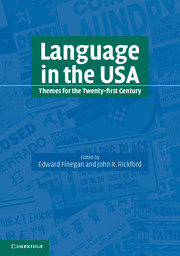Book contents
- Frontmatter
- Contents
- List of figures
- List of tables
- List of contributors
- Acknowledgments
- Foreword
- Editors' preface
- Part 1 American English
- Part 2 Other language varieties
- Part 3 The sociolinguistic situation
- 15 Language ideology and language prejudice
- 16 Ebonics and its controversy
- 17 Language planning, language policy, and the English-Only Movement
- 18 Language in education
- 19 Adolescent language
- 20 Slang
- 21 Hip Hop Nation Language
- 22 Language, gender, and sexuality
- 23 Linguistic identity and community in American literature
- 24 The language of doctors and patients
- 25 The language of cyberspace
- 26 Language attitudes to speech
- Index
26 - Language attitudes to speech
Published online by Cambridge University Press: 05 June 2012
- Frontmatter
- Contents
- List of figures
- List of tables
- List of contributors
- Acknowledgments
- Foreword
- Editors' preface
- Part 1 American English
- Part 2 Other language varieties
- Part 3 The sociolinguistic situation
- 15 Language ideology and language prejudice
- 16 Ebonics and its controversy
- 17 Language planning, language policy, and the English-Only Movement
- 18 Language in education
- 19 Adolescent language
- 20 Slang
- 21 Hip Hop Nation Language
- 22 Language, gender, and sexuality
- 23 Linguistic identity and community in American literature
- 24 The language of doctors and patients
- 25 The language of cyberspace
- 26 Language attitudes to speech
- Index
Summary
Editors' introduction
Some people recognize they speak with an accent, but many others believe their speech carries no accent. The speech of other groups may be accented, but the speech of our own friends and neighbors we tend to perceive as accentless. To a great extent, accents mark the speech of others, of outsiders to our own group, but not of “us.” From the perspective of outsiders, of course, it is not their speech but ours that carries the accent! Accents are salient triggers in our judgments of people. We favor and disfavor people – like and dislike them – partly because of the way they speak. In this chapter, Dennis Preston recounts his investigation of language attitudes among college students in the Midwest and William Labov's earlier investigation in New York City.
Respondents college students in Michigan identified fourteen dialect areas of the USA, the most important being the South, the North, the Northeast, and the Southwest. In characterizing these dialects, respondents college students used polar terms like slow or fast, polite or rude, smart or dumb, good or bad, and educated or uneducated. As in earlier investigations, these judgments about language cluster into a set related to standardness and another set related to friendliness. The respondents gave high marks to their own Northern dialect on the characteristics related to “standardness,” but they rated the Southern accent more “friendly.” Preston interprets this as a group dividing its “symbolic linguistic capital,” apportioning a significant amount to their own dialect for one set of characteristics (in the case of the Michiganders, for standardness) but not for the other (friendliness).
- Type
- Chapter
- Information
- Language in the USAThemes for the Twenty-first Century, pp. 480 - 492Publisher: Cambridge University PressPrint publication year: 2004
- 9
- Cited by

